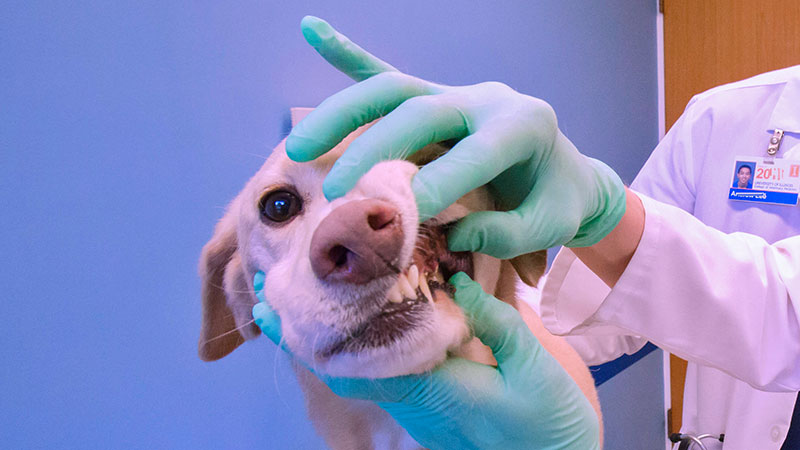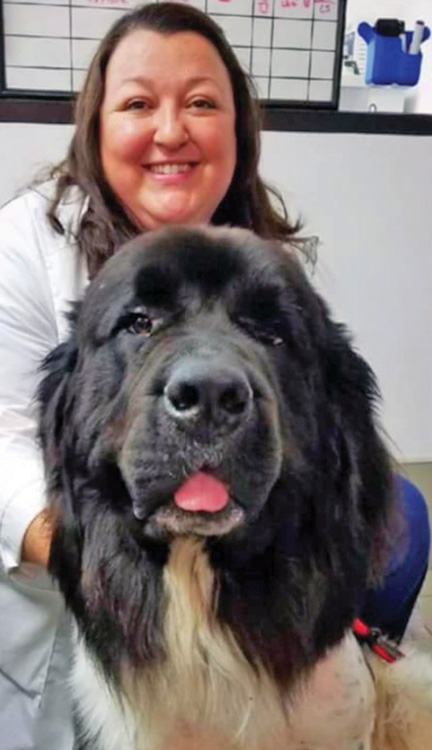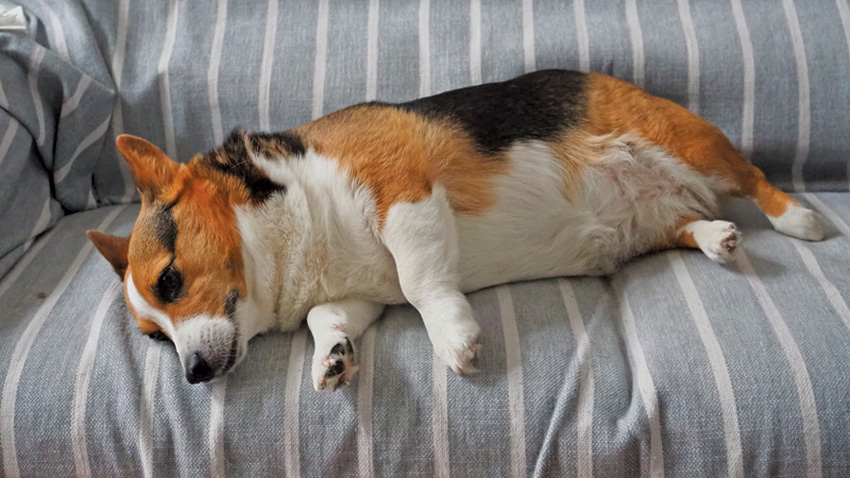In 1990, Dr. Sandy Manfra joined the college’s small animal surgery team with a mandate to expand its veterinary dentistry program. Only two years earlier, the American Veterinary Medical Association had recognized veterinary dentistry as a specialty field. Dr. Manfra had served on the organizing committee to establish the American Veterinary Dental College, enabling veterinarians to gain board certification in this specialty.
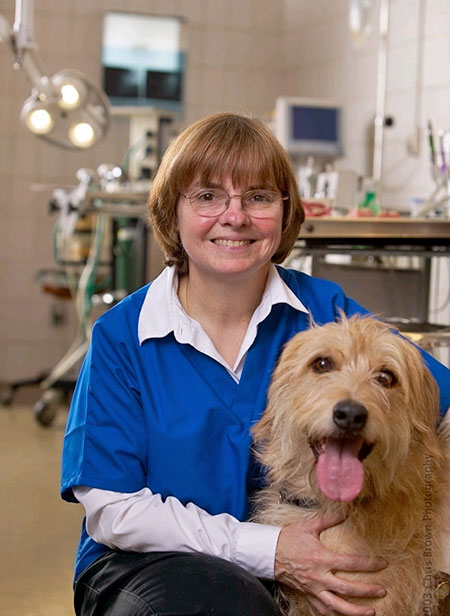
Dr. Manfra was at the forefront in another way: She recognized that online courses, then a new teaching modality pioneered by the Illinois veterinary college, could exponentially increase her ability to provide veterinarians and students with knowledge and skills in dentistry.
Long before most veterinary colleges had dentistry programs, Dr. Manfra was educating Illinois students and creating an online veterinary dentistry curriculum that continues to be used today.
Born of Necessity
As a professor in both small animal surgery and dentistry, Dr. Manfra had to split her attention between seeing patients, conducting surgeries, and teaching students on both the surgery and dentistry rotations. She took fourth-year veterinary students to the Champaign County Humane Society to teach them how to perform dental procedures on local pets awaiting adoption.
“I had to figure out a way to educate the students that were in dentistry while I was over working with surgery,” Dr. Manfra said. “That’s why I developed the online course in dentistry.”
In 2000, with a $2,000 grant from the university, Dr. Manfra purchased a camera to take her own photos for the course. The resulting course, Clinical Small Animal Dentistry, offers 24 hours of continuing education credit focused on modern dentistry techniques for dogs and cats.
While the course was offered exclusively to University of Illinois students in the early 2000s, that began to change once its value was recognized.
Expanding the Reach
“People had heard about the online veterinary dentistry program, and they wanted to know how they could get the program into their schools,” Dr. Manfra recalled. “It all started with the University of Missouri. Dr. Rich Meadows was very interested in helping to teach his students because he was kind of in the same situation that I was.”
Drs. Manfra, Meadows, and others began to seek funding to make the course available to students at no cost. With grants from multiple organizations—including nearly $160,000 over a 15-year period from the American Veterinary Dental College, the Academy of Veterinary Dentistry, and the American Veterinary Dental Society—students at accredited veterinary colleges around the world gained access to the modules.
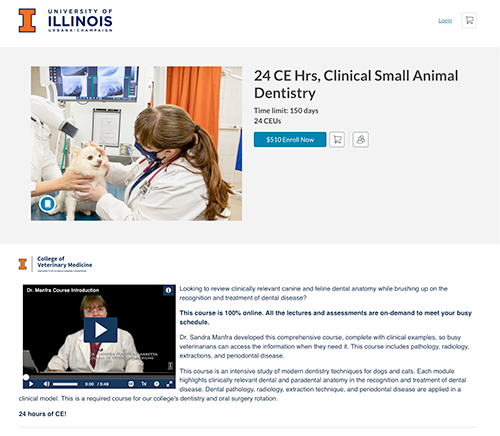
“Dental disease is very common, and unfortunately, some schools don’t include dentistry in their curriculum, or if they do, it’s very limited,” Dr. Manfra said. “The goal of the veterinary dental educators group is to educate all veterinary students before they graduate.”
For more than 15 years, veterinary colleges have been tapping into the online dentistry course to provide dental instruction to their students. Approximately 35 schools around the world have participated, with well over a thousand students enrolling most years.
When the COVID-19 pandemic sent students off campus to learn remotely, the University of Illinois offered the online veterinary dentistry series at no cost to veterinary students worldwide, and nearly 3,000 students enrolled. Even as more colleges have hired dentistry specialists, the course continues to meet a need, with hundreds of students outside Illinois enrolling each year.
Educational Standards Catch Up
It was not until 2020 that accreditation standards for veterinary colleges required instruction and hands-on dental experiences for students. In 2023, an article published in the Journal of the American Veterinary Medical Association identified basic dental care procedures to include on the list of “core competencies” for new veterinary graduates. (Dr. Manfra helped to author this article.)
To meet these new educational standards, Dr. Manfra’s course continues to provide a pathway for dental instruction in veterinary schools. (The link for veterinary students to access the course is vetmed.illinois.edu/ope2/online-vetmed/programs/veterinary-student-courses/.)
“Schools without the resources to provide the necessary didactic coursework in veterinary dentistry can enroll their students in this online course, enabling their students to accumulate 2 credit hours of education in dentistry from their home university, pending successful completion of the course,” Dr. Manfra explained.
“The only thing the schools would have to add to the online course is the hands-on labs and clinical experience with dental patients.”
Dedicated Owner Launched It All
Dr. Manfra retired from the University of Illinois in 2013. Looking back, she says the creation of her online dental course gives her the greatest pride. The course expanded access to veterinary dentistry education and helped pave the way for increased interest and awareness of the field.
But she cannot tell the full story without crediting a pet owner who helped make it all possible. In the late 1970s, Janet Mertz, from Decatur, Illinois, had a dog named Sheba that suffered from serious dental problems. At that time, there were only two veterinarians in the world qualified to treat Sheba’s condition.
After taking Sheba to Texas to see one of these specialists, Ms. Mertz decided to make a generous donation to the University of Illinois to establish a veterinary dentistry program. She wanted to ensure that patients in her state would have access to care and that more veterinarians would have basic or advanced dentistry skills. Her gift, made in 1982, helped attract Dr. Manfra to the Illinois position in 1990.
Dr. Manfra and the donor forged a friendship and shared a passion for veterinary dentistry. When Ms. Mertz passed away in 2008, she left a $400,000 endowment for the dental program to honor Dr. Manfra’s service. She lived to see the dentistry program at the University of Illinois flourish through the training of numerous dental residents and the creation of a strong veterinary dental education program that reaches thousands of veterinary students, which was her vision.
By Haley Maser

